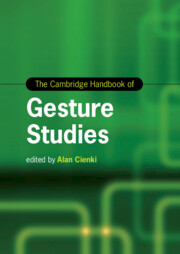Book contents
- The Cambridge Handbook of Gesture Studies
- Cambridge Handbooks in Language and Linguistics
- The Cambridge Handbook of Gesture Studies
- Copyright page
- Contents
- Figures
- Tables
- Contributors
- Introduction
- Part I Gestural Types: Forms and Functions
- Part II Ways of Approaching Gesture Analysis
- Part III Gestures and Language
- Part IV Gestures in Relation to Cognition
- 18 The Growth Point
- 19 Gestures in Cognition: Actions that Bridge the Mind and the World
- 20 The Neuroscience of Gesture Production
- 21 Gesture in Learning and Education
- Part V Gestures in Relation to Interaction
- Index
- References
21 - Gesture in Learning and Education
from Part IV - Gestures in Relation to Cognition
Published online by Cambridge University Press: 01 May 2024
- The Cambridge Handbook of Gesture Studies
- Cambridge Handbooks in Language and Linguistics
- The Cambridge Handbook of Gesture Studies
- Copyright page
- Contents
- Figures
- Tables
- Contributors
- Introduction
- Part I Gestural Types: Forms and Functions
- Part II Ways of Approaching Gesture Analysis
- Part III Gestures and Language
- Part IV Gestures in Relation to Cognition
- 18 The Growth Point
- 19 Gestures in Cognition: Actions that Bridge the Mind and the World
- 20 The Neuroscience of Gesture Production
- 21 Gesture in Learning and Education
- Part V Gestures in Relation to Interaction
- Index
- References
Summary
Gesture is a powerful tool for learning. Gestures reflect a learner’s knowledge and also have the power to change that knowledge. But how early does this ability develop and how might it change over time? Here we discuss the effects of gesture on learning, taking a developmental perspective. We compare how young learners benefit from gesture prior to developing full language skills, as well as how gesture and language work together to support instruction in older children. For both developmental stages, we explore three ways in which gesture can influence learning: (1) by indexing or reflecting a learner’s knowledge, (2) by changing that knowledge through the gestures that learners themselves produce, and (3) by changing that knowledge through the gestures that learners see. Taken together, the evidence suggests that gesture plays a powerful role in learning and education throughout development.
- Type
- Chapter
- Information
- The Cambridge Handbook of Gesture Studies , pp. 556 - 576Publisher: Cambridge University PressPrint publication year: 2024

